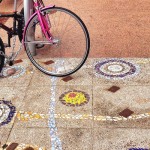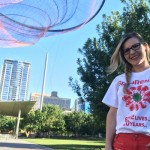Downtown is more than a grid system of streets and square miles. It is experienced in the sights, sounds, feel and tastes that are unique to the place. In this short series, DPJ contributor, Colin Columna hones in on the five senses as his guide to explore what makes downtown Phoenix unique.
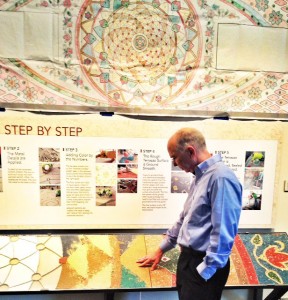 The Phoenix Public Art Program was launched in 1986 through a visionary ordinance that allocates one percent of the Phoenix Capital Improvement Program to enhancing the design of public buildings, infrastructure and spaces. The program has been uniquely successful because Phoenix is a relatively new city. Unlike older urban communities, Phoenix has available open space in which to plan and build its future and a citizenry with hands-on involvement in that growth. In the last 28 years, the program has created more than 180 art installation projects throughout the city in neighborhood parks, on bridges, along canals, on public streets, in recycling centers, at airports and in civic gathering places. By bringing together artists, residents, architects, engineers and landscape designers to integrate art into the infrastructure of our communities, the program adds to the dialogue of how we relate to our urban environment.
The Phoenix Public Art Program was launched in 1986 through a visionary ordinance that allocates one percent of the Phoenix Capital Improvement Program to enhancing the design of public buildings, infrastructure and spaces. The program has been uniquely successful because Phoenix is a relatively new city. Unlike older urban communities, Phoenix has available open space in which to plan and build its future and a citizenry with hands-on involvement in that growth. In the last 28 years, the program has created more than 180 art installation projects throughout the city in neighborhood parks, on bridges, along canals, on public streets, in recycling centers, at airports and in civic gathering places. By bringing together artists, residents, architects, engineers and landscape designers to integrate art into the infrastructure of our communities, the program adds to the dialogue of how we relate to our urban environment.
A good starting point for discovering public art in Phoenix is at The Gallery @ City Hall on Washington St. and Third Ave. Currently on view in the gallery is Art Under Foot: Handmade Floors at the PHX Sky Train. The exhibit highlights the dynamic collaboration between the four artists and the many skilled craftspeople involved in creating the commissioned terrazzo floors at the PHX Sky Train stations. Included in the exhibit are artists’ original drawings, computerized models, hands-on displays, and a short video describing the 40,000 hours of labor required to complete the project. The exhibit makes visible how the process works, how artists are involved from the beginning, and how the art is integral to the overall project.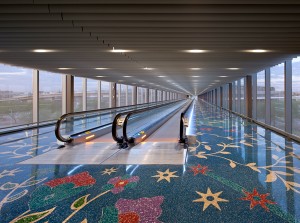
“Public art,” states Ed Lebow, Phoenix Public Art Program Director, “and the Phoenix Public Art Program in particular, allows us the opportunity ask the impertinent question ‘What if?’ to the blank concrete stares of most urban settings. What if we imagine new ideas for the purpose of public spaces? How can we enhance the experience of traveling through these urban places? Is it possible that an installation can improve a community’s quality of life?”
The answers involve many steps, and many hands, from artist conception to art installation. “The nature of commissioned work is site specific,” Lebow explains. “A place designated for the art piece to be conceptually integrated, to be one of the components of the fully realized project.” Within those parameters, or restrictions, “intensive problem solving occurs. Each project is completed through a collaboration of thinkers.”
The placement of artworks in neighborhoods and public spaces, and as functional elements within those environments – walkways, gateways and bridges – challenges a cardinal rule of art engagement: Don’t touch. “The joy of art is very tactile,” counters Lebow. “Each work is created by the touch of artists: molded, painted, built. They are artworks, but first they are works created by hand. I don’t believe they are something removed or special, but a part of life,” he explains.
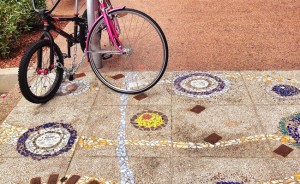 Trained as a potter in college, Lebow confesses he “fell off the wheel” to explore other endeavors, but his personal and physical relationship with created works is evident. As a potter applies glaze, he describes the Taylor Streetscape as layers of experience. “The sidewalks are expanded and embedded with artwork to encourage strolling. So touch may be the first sense engaged. Trees are a vital part of the design and set in wide basins, capturing and reflecting water during rainy seasons. Pedestrians hear the sound and feel the cool breeze through their branches. Or they smell the plants as they respond to changes in atmosphere.” In this way, the art lives in the community.
Trained as a potter in college, Lebow confesses he “fell off the wheel” to explore other endeavors, but his personal and physical relationship with created works is evident. As a potter applies glaze, he describes the Taylor Streetscape as layers of experience. “The sidewalks are expanded and embedded with artwork to encourage strolling. So touch may be the first sense engaged. Trees are a vital part of the design and set in wide basins, capturing and reflecting water during rainy seasons. Pedestrians hear the sound and feel the cool breeze through their branches. Or they smell the plants as they respond to changes in atmosphere.” In this way, the art lives in the community.
Since its inception, the program has garnered numerous awards for design excellence, including two Design for Transportation Awards from the U.S. Department of Transportation and the National Endowment for the and, several Valley Forward Association Environmental Excellence Awards. Most recently, the Americans for the Arts Public Art Network Year in Review named two Phoenix projects, Ground Cover and Desert Spring, among the nation’s top 37 public arts projects.
“As we build our city,” Lebow says, “public art allows us to create a balance of the aesthetic and the practical…and an environment to keep our senses engaged.”
The Phoenix Office of Arts and Culture manages the city’s public art program, administers a grants program, supports arts learning, provides information and assistance to artists and cultural organizations, and oversees the city’s cultural planning efforts.
One way to start your own downtown Phoenix Public Art Tour is to visit The Gallery @ City Hall, or download a self-guided map to the public art located throughout downtown Phoenix.
If You Go
Where: The Gallery @City Hall, 200 West Washington Street (ground floor)
When: 10:00 am to 2:00 pm, Monday through Friday.
Cost: The Gallery is free and open to the public. In addition to the exhibition, self-guided public art maps are available in the gallery and online.


